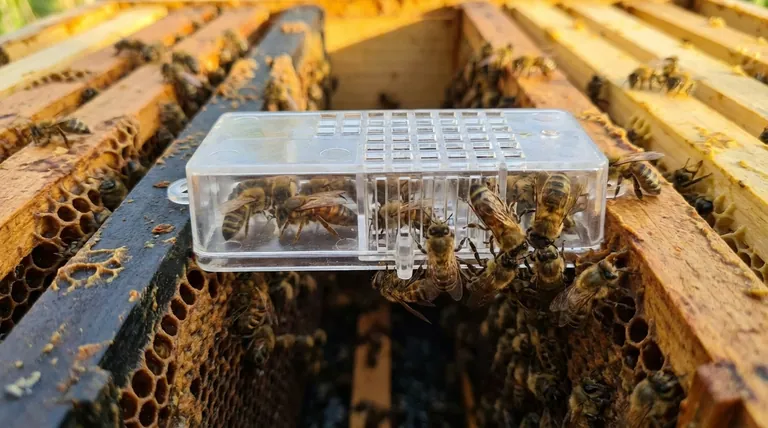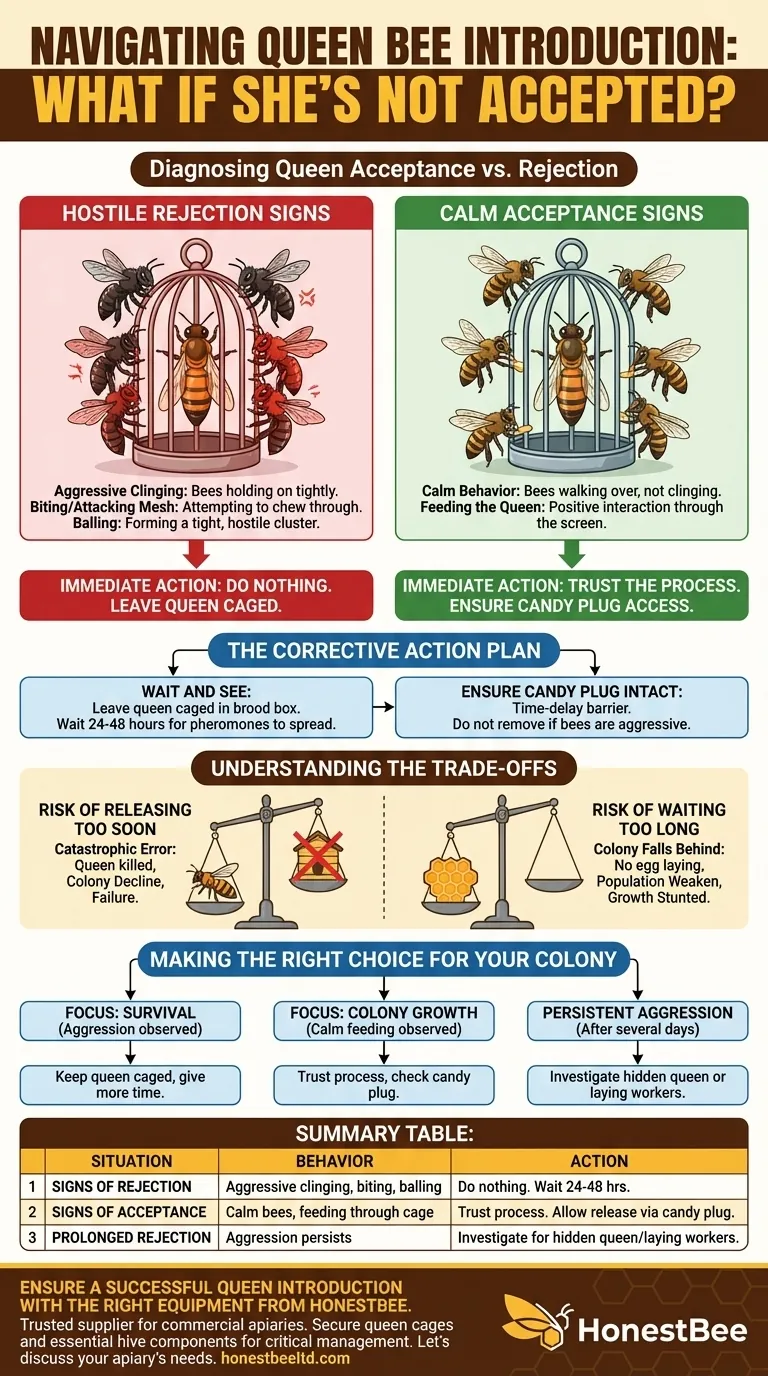If you see signs of rejection, your immediate action is to do nothing—do not release the queen. Hostile behavior, such as bees clinging to or biting the cage, is a clear signal that the colony is not yet ready to accept her. Give the hive more time to acclimate to her pheromones before taking any further steps.
The success of a new colony hinges on the slow, deliberate introduction of its queen. Rushing this process by releasing her into a hostile environment almost guarantees her death and sets the colony on a path to failure.

Diagnosing Queen Acceptance vs. Rejection
Before you can act, you must accurately interpret the behavior of the worker bees toward the caged queen. Your observation is the most critical diagnostic tool you have.
The Clear Signs of Rejection
Hostility from worker bees is unmistakable. Look for bees aggressively clinging to the cage, even when you gently brush them aside.
They may appear to be biting or attacking the wire mesh. In the most extreme cases, they will form a tight "ball" around the cage in a concerted effort to sting and overheat the queen, a behavior known as "balling."
The Subtle Signs of Acceptance
A colony that is accepting a new queen will behave with relative calm. Worker bees may walk over the cage, but they will not be clinging aggressively.
The most positive sign is seeing workers feeding the queen through the screen. This demonstrates they have accepted her as the new mother of the colony and are tending to her needs.
The Corrective Action Plan
If you have diagnosed rejection, your goal is to manage the introduction process to change the bees' behavior from hostile to nurturing.
The "Wait and See" Approach
Your first and most important strategy is patience. Leave the queen secured in her cage between two frames in the brood box.
This extra time allows the queen's unique pheromones to spread throughout the hive, slowly suppressing the workers' defensiveness and making them more receptive. Check back in another 24 to 48 hours.
Ensure the Candy Plug is Intact
The queen cage is designed with a candy plug for a reason. This sugar barrier acts as a time-delay mechanism.
The bees must chew through the candy to release the queen, a process that typically takes several days. This forces a slow introduction, giving the colony the necessary time to acclimate. If you see aggression, ensure this plug has not been breached or removed prematurely.
Understanding the Trade-offs
Managing queen introduction involves balancing two competing risks. Your decisions directly impact the colony's future viability.
The Risk of Releasing Too Soon
This is the most catastrophic error. Releasing a queen into a hostile hive will result in her immediate death. The workers will surround and kill her.
The consequence is a queenless colony with no way to produce a new one. This will lead to a rapid decline in population and the eventual death of the entire hive unless you intervene again with a new queen.
The Risk of Waiting Too Long
While patience is critical, leaving a queen caged for an excessive period (e.g., more than a week) has its own costs.
A caged queen cannot lay eggs. Every day she is confined is a day the colony is not replenishing its population. This can cause the colony to fall behind, weakening its workforce just as it needs to grow.
Making the Right Choice for Your Colony
Your actions in the next few days are critical. Base your decision on the clear behaviors you observe inside the hive.
- If your primary focus is survival: See any sign of aggression like biting or balling? Keep the queen safely in her cage and give the colony more time to accept her scent.
- If your primary focus is colony growth: See calm bees feeding the queen? Trust the process, ensure the candy plug is accessible, and allow the bees to release her on their own schedule.
- If aggression persists after several days: The colony may have another hidden queen or laying workers. You must solve that underlying issue before attempting to re-introduce a new queen.
Ultimately, successful queen introduction is achieved by letting the bees, not the beekeeper, decide when the time is right.
Summary Table:
| Situation | Worker Bee Behavior | Immediate Action |
|---|---|---|
| Signs of Rejection | Aggressive clinging, biting cage, balling | Do nothing. Leave queen caged. Wait 24-48 hours. |
| Signs of Acceptance | Calm bees, feeding queen through cage | Trust the process. Allow bees to release her via candy plug. |
| Prolonged Rejection | Aggression persists after several days | Investigate for a hidden queen or laying workers before re-introduction. |
Ensure a successful queen introduction with the right equipment from HONESTBEE. A weak or failing colony often starts with a failed queen introduction. As a trusted supplier of beekeeping supplies and equipment to commercial apiaries and distributors, we provide the durable, reliable tools you need for critical hive management. From secure queen cages to essential hive components, our wholesale-focused operations ensure you get the quality gear required for a thriving operation. Let's discuss your apiary's needs — contact our team today to strengthen your beekeeping success.
Visual Guide

Related Products
- Professional Multi-Functional Queen Bee Cage
- Durable Galvanized Steel Spring Queen Bee Cage
- Multi-Function Queen Roller Cage and Catcher
- Professional Multi-Compartment Queen Cage with Sliding Lid
- Wood and Mesh Push-In Queen Cage
People Also Ask
- How should a queen cage be maintained over time? Ensure Queen Introduction Success
- What items are needed to place the queen bee's cage in the hive? A Guide to Successful Queen Introduction
- What are the components of a standard queen cage? A Guide to Safe Queen Introduction
- What are common mistakes to avoid when using queen cages? Ensure Successful Queen Introduction
- How do you check if the queen has been released after installation? A Guide to Successful Queen Acceptance



















